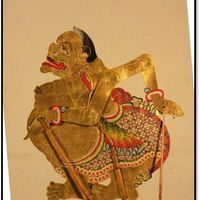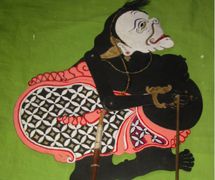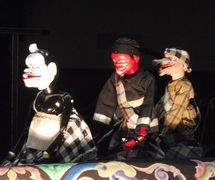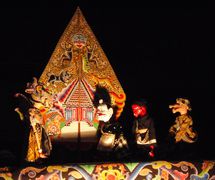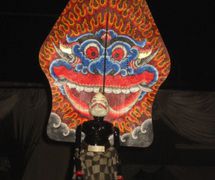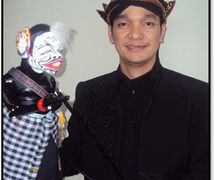The main clown (punakawan) of the wayang of Java and Sunda, Indonesia, present in shadow theatre (wayang kulit), rod puppetry (wayang golek), mask theatre (topeng), dance drama (wayang orang) and other genres. The same name for the clown may occur in Malaysian areas where Javanese influence is strong, in Sumatra or Kalimantan, in shadow genres around Jakarta (Betawi), and sometimes even the god-clown of Bali Twalen may be addressed by this name. Semar is the oldest and most important god-clown and we find him or his analogue throughout South East Asia.
Even in genres where he may go under a different name (Sabda Palon in Panji stories performed in wayang cepak rod puppetry or sometimes wayang klitik (flat wooden puppetry) the figure will have the same iconography, with a pot belly, protruding belly button, black body, white face, and a tuft/bump on his forehead (kuncung). His sarong is usually a black and white check pattern or a white-yellow-red-black check that is linked to sacred binaries (life-death, day-night, male-female, etc.) or quintals (four directions and centre, the five elements earth, air, water, fire, ether, etc.). Imagery represents his mythic import: he is half male and half female, his body is black to represent night and his face white to represent day, his belly is large because he swallowed the great world mountain, the bump on his head is said to be “the axis of which the universe turns”, etc.
As the first principle that emerged from the cosmic egg at the beginning of the universe, Semar represents divine wisdom at its comic and wisecracking best.
Semar is a fool, a buffoon, a “clown” and yet the most important figure in the wayang set. He appears in Mahabharata stories serving the Pandawa hero Arjuna, one of Arjuna’s sons or some other righteous figure. In Ramayana-based tales he will serve Rama. He is the main clown of the “right hand” side of the stage and always serves the more positive characters. He is balanced of course by his brother Togog, who serves the more demonic forces of the “left”, supposedly noting their sins for the reckoning of some final judgement. Semar’s bosses will normally prevail at the end of the story presented since he has brought down from heaven with him the layung jamus kalimasadah, an heirloom treasure (pusaka) which is inherited in each generation of wayang by the heroes that preserve and maintain cosmic order. Semar appears in each story through all the ages and generations of wayang stories because he is the caretaker of this important pusaka.
Semar may have a slightly different number of sons and they may have different names or characteristics in different parts of the Indonesian archipelago or in different theatre genres: Gareng, Petruk, and Bagong are usually the sons he has in Central Java; Astrajingga, Petruk, and Gareng are likely to appear in Sunda (West Java); a set of nine sons and their offspring appear in the Cirebon area on the north coast of Java (people say there are nine since there were nine wali, saints who converted the Island to Islam). Semar’s sibling, Togog, was cast out of heaven with him. Togog and his sidekick Bilung are the clowns of the “left”.
Semar is said to represent the voice of the people and is free to speak anachronistically or use direct address to the audience. He can talk about issues of the present. Though old, farting, and comical, he is also considered the wisest and most important figure in the set. In some areas, in times past, puppeteers might dip the tip of his central rod into water to make “holy water” in ceremonies that made people, places, or crops safe. Semar is associated with the god of love (Asmara) and his name sometimes comes up in love charms. When he appears in his refined divine body instead of his fat clown one, he is a knightly figure, Sanghyang Ismaya (Ismoyo). He is the elder sibling of Batara Guru (Siwa, Indian Shiva), and in many episodes proves more powerful than this high god of the universe, who is supposed to be the top of the hierarchy of the wayang world.
In a Javanese wayang kulit (shadow theatre) performance, the scene where Semar traditionally emerges is called the goro-goro (“world in chaos”). The narration of the puppeteer speaks of earthquakes and storms that beset the cosmos, but then announces that Semar appears like a shaft of light, piercing the dark. Semar’s cosmic and comic humour promises the audience both laughs and wisdom. He is a clown who connects the cosmic and everyday. All opposites and contradictions dissolve in his wisdom and mythos. Semar is a South East Asian variant of the puppet/mask clown that we find in areas of China, India, and all over South East Asia.
(See Indonesia.)
Bibliography
- Epskamp, C.P. Semar as Trickster. Wayang as a Multi-classificatory Representation of Javanese Society. Leiden: Instituut voor Anthropologie en Sociologie der Niet Westerse Volken, Rijksuniversiteit Leiden, 1976.
- Foley, Kathy. “The Clown in the Sundanese Wayang Golek: Democratization of a Feudal Ethos”. Scenarium. Vol. 8, 1985, pp. 88-99.
- Foley, Kathy. “The Clown Figure in the Puppet Theatre of West Java: The Individual and the Ancestor”. Humor and Comedy in Puppetry. Ed. Diana and Joel Sherzer. Bowling Green: Bowling Green State Univ. Popular Press, 1987.
- Foley, Kathy. “Semar in Sunda. The Southeast Asian God-Clown in His Sundanese Embodiment”. RIMA. Vol. 33, No. 2 (Summer), 1999, pp. 87-107.









